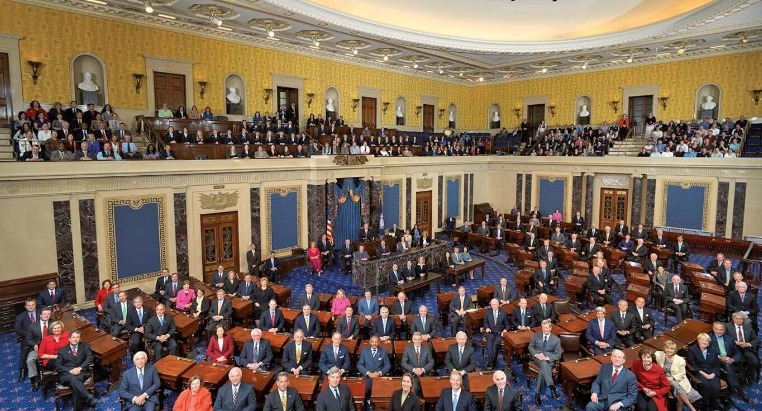Table of Contents

Senate seats: “Analyzing the 2024 U.S. Senate Elections: A Decisive Year for Congressional Balance”
Introduction:
The United States Senate seats , a crucial component of the American legislative system, plays a pivotal role in shaping the nation’s policies and laws. Every six years, a portion of the Senate seats goes up for election, and 2024 is no exception. With 34 seats in contention, this election cycle holds particular significance as it has the potential to reshape the balance of power in the Senate for the 119th Congress.
The 2024 U.S. Senate elections represent a critical juncture in American politics, with 34 seats hanging in the balance. As the legislative branch plays a pivotal role in shaping the nation’s policies and laws, the outcomes of these elections will have far-reaching consequences. This in-depth analysis seeks to unravel the complexities of the electoral landscape, examining the current party standings, the unique dynamics of Republican and Democratic campaigns, the influence of independent senators, and the impact of special elections in Nebraska and California. Ultimately, the balance of power in the Senate for the 119th Congress hinges on the decisions made by voters across the nation.
I. Overview of the 2024 U.S. Senate Elections:
In the upcoming 2024 elections, a total of 34 Senate seats are up for grabs. To gain a comprehensive understanding of the dynamics at play, it’s essential to delve into the details. As of now, Republicans hold 10 seats, Democrats occupy 20, and three seats are held by independents who caucus with the Democrats. Additionally, two special elections are scheduled in Nebraska and California, adding an extra layer of intrigue to the electoral landscape.
II. The Republican Perspective: seats
As the party currently in the minority, Republicans are keenly focused on retaining their existing seats and gaining ground to secure a stronger position in the Senate. A closer look at the Republican-held seats up for election, the demographics of their constituencies, and the political climate will provide insights into their strategies and challenges.
III. The Democratic Outlook:
With a majority in the Senate, Democrats aim to maintain their stronghold while also eyeing opportunities for expansion. Examining the Democratic-held seats, the key battleground states, and the issues dominating the political discourse will shed light on their prospects and potential areas of vulnerability.
IV. Independent Influence:
The three independent senators who caucus with the Democrats wield significant influence in the Senate. An exploration of their roles, the issues they prioritize, and their potential impact on the balance of power adds complexity to the electoral landscape.
V. Special Elections in Nebraska and California:
Two special elections in Nebraska and California are poised to play a crucial role in determining the overall composition of the Senate. The unique circumstances surrounding these elections, the candidates involved, and the issues resonating with voters will be instrumental in forecasting the potential outcomes.
VI. Factors Shaping the Elections:
Several factors contribute to the intricacies of the 2024 Senate elections. Analysis of the political climate, public sentiment, and the influence of national and global events will help elucidate the broader context within which these elections are taking place.
VII. Potential Impact on Congressional Balance:
The outcome of the 2024 Senate elections holds significant ramifications for the balance of power in the 119th Congress. A detailed examination of potential scenarios, including shifts in the majority or the preservation of the status quo, will provide a clearer picture of the implications for legislative dynamics.
Republican Perspective:
For Republicans, the 2024 elections present an opportunity to regain ground in the Senate. With 10 seats currently held by the party, a strategic approach is imperative to both defend existing strongholds and target competitive races.
A detailed exploration of the demographics :
A detailed exploration of the demographicsof states with Republican incumbents, key issues that resonate with their constituents, and the challenges posed by the evolving political landscape will provide insights into the party’s electoral strategies and potential obstacles.
Democratic Outlook:
Democrats, holding a majority in the Senate, face the task of defending 20 seats while also seeking opportunities for expansion. A closer examination of Democratic strongholds, the dynamics of battleground states, and the prevailing issues dominating political discourse will illuminate the party’s prospects in the 2024 elections. Understanding the delicate balance between maintaining existing seats and pursuing new ones is crucial for Democrats aiming to solidify their position in the Senate.
Independent Influence:
The three independent senators who caucus with the Democrats add a layer of complexity to the Senate’s political composition. An exploration of their roles, policy priorities, and the nuances of their alliances will shed light on how their positions may influence the overall balance of power. As key swing votes, the independent senators hold the potential to tip the scales on critical legislative decisions.
Special Elections in Nebraska and California:
The inclusion of special elections in Nebraska and California introduces a unique dynamic to the 2024 Senate elections. These races, often influenced by local issues and candidate personalities, can have a substantial impact on the overall balance of power. A detailed analysis of the candidates, the political climate in each state, and the issues that resonate with voters will be instrumental in predicting the outcomes of these pivotal contests.
Factors Shaping the Elections:
Several factors contribute to the complexity of the 2024 Senate elections. The broader political climate, public sentiment, and the influence of national and global events all play a role in shaping voter attitudes. A comprehensive examination of these factors will help to gauge the fluidity of the electoral landscape and anticipate how external forces may impact the outcomes of individual races.
Potential Impact on Congressional Balance:
The ultimate significance of the 2024 Senate elections lies in their potential to reshape the balance of power in the 119th Congress. Scenario analyses, considering various electoral outcomes and their implications for majority control, will offer valuable insights into the potential trajectory of legislative dynamics. As the nation stands at the crossroads of political change, the decisions made by voters in 2024 will resonate in the corridors of power for years to come.
Conclusion:
As the nation anticipates the 2024 U.S. Senate elections, the stakes are high, and the political landscape is rife with uncertainties. This comprehensive analysis has delved into the details of the upcoming elections, examining the perspectives of Republicans, Democrats, and independent senators, as well as the impact of special elections. The outcome of these elections will undoubtedly shape the trajectory of the 119th Congress, influencing the legislative agenda and the direction of the nation as a whole.
There are 34 Senate seats up for election in 2024.
